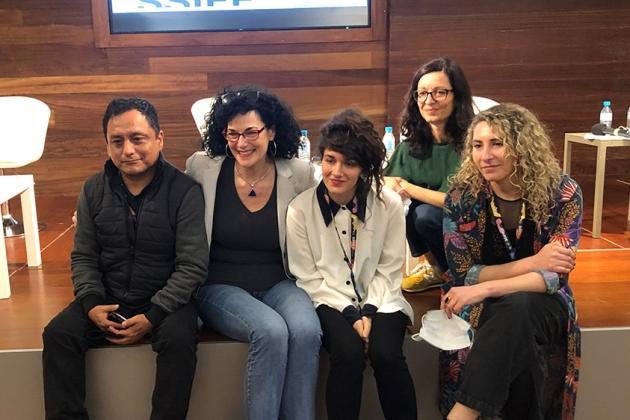
Taking place inside a cool, concrete extension of the San Telmo Museum, a dedicated Basque cultural hub, the challenges facing LGBTQI+ cinema in Latin America was the subject an industry panel at San Sebastian International Film Festival.
Participants included Patra Spanou of the eponymous German sales outfit, which handled sales for the homoerotic feature “El Príncipe;” festival programmer and producer Hebe Tabachnik, producer of “Valentina;” Clarisa Navas, director and scriptwriter of Berlin hit “One in a Thousand,” a lesbian love story set on the working class outskirts of Argentina’s Corrientes; and Gabriela Sandoval, a multi-hyphenate producer and distributor at Chile’s Storyboard Media, head of Sanfic Industria and executive director of the Amor LGBT + Film Festival. Moderator Rolando Salazar of Festival Outfest Peru led the discussion.
More from Variety
Spanou spoke about the nuances of reaching distributors.
“We deal with arthouse films, and our first concern is with the film and arthouse sector and then it’s with the LGBT story so that you can attract specific distributors,” she says. “There are smaller categories that might take films for video or because they are sexy or because they are supporting these communities.”
Tabachnik has been programming festivals for 20 years in the U.S. and Latin America. She executive produced the Brazilian trans film “Valentina,” by Cássio Pereira dos Santos in 2020.
“It took seven years to make it but it couldn’t be made today because these films are censored by funds,” she says. “We can see progress but also that we have gone back, especially in Brazil which is a conservative society making financing difficult.”
Cássio Pereira dos Santos’s film had its world premiere at the Outfest Los Angeles LGBTQ Film Festival during the pandemic. “In the case of “Valentina,” we were able to sell it to platforms in multiple territories. But talking to friends, producers, it’s like we want gay cowboys that meet in the mountains. That’s what we want to see,” she adds.
Sandoval spoke about the role of festivals in creating much needed LGBTQI+ spaces. “In film festivals, we create spaces for the audience. 10 years ago, it was a different situation. Today filmmakers are more aware about relating to the audience and its diversity,” she said.
She added: “Sometimes we feel that we have not moved forward. We tackle hatred with festivals raising awareness about subjects that make society uncomfortable. But we’ve seen many societies go back during the pandemic, practicing violence.”
That said, opportunities to distribute films in the LGBTQI+ space have increased as has the the quality of filmmaking.
Says Tabachnik: “New channels have encouraged the distribution of this content. Knowing that people that make LGBT content now have a space is helping expand the sector.”
One positive factor is that storytelling is becoming more varied, notes Sandoval: “Lesbian cinema was not very well represented but now we are beginning to see good content and themes.”
Tabachnik added: “The work required is a collective effort that has to do with generating audiences, creating spaces for alternative creators. Help for circulation of this kind of content. You have to get audiences accustomed to things.”
She went on: “People get accustomed to seeing certain things. In 10 years we are going to have stories you can’t even imagine. I think it will be far more fluid. Young people today are far more open.”
Best of Variety
Sign up for Variety’s Newsletter. For the latest news, follow us on Facebook, Twitter, and Instagram.








